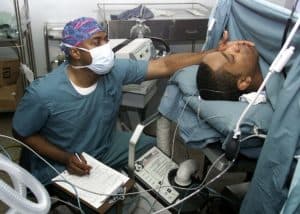What is CRBSI?
CRBSI often confused with CLABSI (Central line associated bloodstream infection) is the one in which a patient clinically shows the signs of bloodstream infection with precise laboratory findings where the source of infection is clearly identified as the intravenous catheter placed into the patient’s body at any time and is still on.
Like CLABSI, CRBSI is also associated with the central venous catheter in most cases. However, CRBSI may also be due to an infection from any other peripheral intravascular catheter throughout the body.
Prevalence of CRBSI
- The prevalence of CRBSI is measured “as the number of infections per 1000 catheter-days”.
- In the United States, 90% of the CRBSI occur due to central venous catheter.
Causative Organisms
The most common organisms causing CRBSI are:
- Staphylococci (Staphylococcus aureus, coagulase-negative staphylococci)
- Enterococci
- Aerobic gram-negative bacilli
- Some yeast
Risk factors
CRBSI as mentioned earlier occurs in patients with intravascular catheters placed in their bodies. But not all catheterized patients will acquire infection. Following are the conditions in which the catheterized patient is more prone to have CRBSI:
- Severe illness thus destroys one’s immune system.
- Granulocytopenia.
- Presence of prior infection in any part of the body.
- Break in the integrity of the skin around the insertion site.
Risk also increases with the breaks of aseptic precautionary measures during insertion and management of the intravascular catheters.
Diagnosis
The suspicion of CRBSI is done when there is evidence of systemic inflammatory response in a patient with an intravascular catheter.
The signs of the systemic inflammatory response may be as follows:
- Either hypothermia or hyperthermia (Temperature either >38 degrees celsius or <36 degrees celsius).
- Tachycardia (Heart rate >90/minute).
- Tachypnea (Respiratory rate > 20/minute).
- An abnormal leukocyte count in the peripheral blood film.
With these signs, it is almost confirmatory that the patient has CRBSI. However, the absence of any other identifiable non-vascular source of infection along with these is diagnostic of CRBSI.
Furthermore, at least two blood cultures should be performed; one from the tip of the catheter and the other one from another peripheral venipuncture site for the purpose of organism detection and treatment accordingly.

Treatment
- Suspected Cases:
- Even before the arrival of blood culture reports, the suspected cases of CRBSI should be treated with empirical antibiotic therapy.
- The mode of therapy should be the catheter line lock (which means a high concentration of antimicrobials is flushed into the catheter.
- The choice of antibiotics will depend upon the severity of symptoms.
- Blood culture positive cases:
After the arrival of blood culture reports, the specific systemic antibiotics against the obtained organism should also be added to the catheter line empirical therapy.
- The duration of antibiotic therapy varies according to the severity as well as the organism detected.
- However, 7-14 days of antibiotic therapy is ideally given.
- If there is no improvement in the patient’s symptoms even after the therapy, the catheter should be removed.
Prevention
The prevention of CRBSI depends upon a wide range of steps to be followed at different steps. Prevention should focus on the local site asepsis, proper aseptic precautions of the doctor or nurse, proper training to the healthcare provider, and so on.
The following measures should be followed to prevent the incidence of CRBSI to some extent:
- Maintenance of proper asepsis in and around the site of catheterization:
Both during the insertion as well as maintenance of the catheter the area in and around the catheter site should be cleaned with chlorhexidine solution timely to maintain asepsis. This will prevent the entry of organisms from the surrounding skin surface.
- Ensure proper self aseptic precaution:
The healthcare provider should maintain all the safety protocols before handling the catheter both during the insertion as well as maintenance.
Sterile gloves, gowns, caps, and masks should be worn to ensure as minimal contamination as possible.
- Proper training to the healthcare provider:
Despite the fact that many healthcare providers are performing the procedure, some of them are still unaware and not well trained about the exact way of performing it. Such instances bring about more risk of causing unwanted infections. Hence, it is important to train all the healthcare providers about the procedure itself as well as the aseptic measures.
- Avoid routine placement of intravascular catheters:
It is really important to be wise and selective in the cases which actually require intravascular catheterization. Avoidance of catheterization in cases where it is not really required will also help to reduce the chance of developing bloodstream infection as a whole.
Please write your thoughts in the comment section. Here are some other relevant articles for you:



